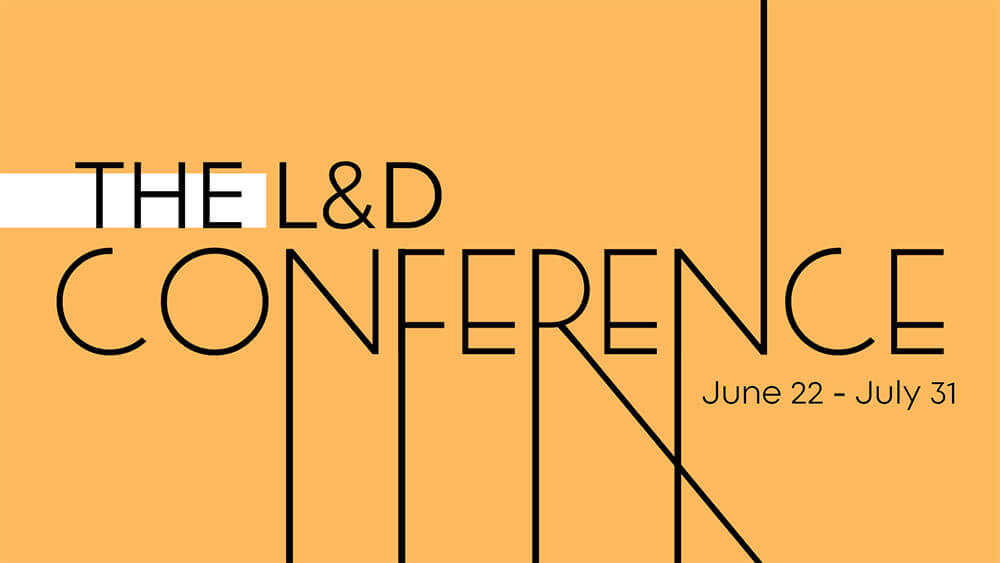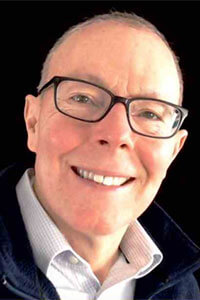
TheL&D Conference was conceived as a digital event because an online platform is more aligned with learning principles than typical face-to-face events, organizers said.
Many organizers who were forced to cancel or postpone their face-to-face events during the coronavirus crisis improvised by quickly shifting to digital. But for the organizers of the inaugural L&D Conference — Will Thalheimer, Ph.D., Matt Richter, and Ashley Sinclair — going online is not about making do during the pandemic, it’s about making up for an inherent weakness of face-to-face events. They’re simply not, Thalheimer told Convene, designed to be optimal learning environments.
And when it comes to learning, Thalheimer and Richter are experts. Thalheimer, president of the Somerville, Massachusetts–based Work-Learning Research Inc., and Albany, New York–based Richter, president of The Thiagi Group, collaborate on a podcast called “Truth in Learning.” The two had been brainstorming about other ways to share their perspectives in the L&D (learning and development) industry, a field that focuses on providing and managing job-related training to employees and individuals.
In early March, as they saw events being canceled due to the coronavirus, they began exploring the idea of launching their own digital conference and reached out to partner with Sinclair, director/owner of Maas Marketing, who is based in the U.K. and specializes in the L&D field.
“We wanted to take all the best stuff of conferences,” including great speakers and networking, Thalheimer said, “and bring it online, but also overcome some of the limitations of a conference. So, for example, you go to a conference, and it’s over two or three days, and you might actually get to 12 sessions. Say two of them are really good — a lot of them are mediocre, and then there’s a few bad ones. But say you get some really important nuggets — you’ve only been in that session for 60 minutes. That’s not really enough time. We know from the learning science that’s not enough time to do a lot of practice, really go deep in the subject. You’re really just getting a taste for it. Then you might go back to the workplace, and you’ve got all these other priorities. So, the memory of what you learned fades, and you don’t have contact with a speaker anymore.”
Designing a Learning Environment
As learning architects designing an online learning experience, Thailheimer said that they knew they had to do better than just string “a bunch of webinars” together and call it a conference. Their first departure from the norm in both online and live events is The L&D Conference’s duration. Rather than being held over a few days, the conference runs over six weeks, June 22 through July 31. A secondary distinction is the mix of asynchronous (on-demand viewing) and synchronous (live participation) online sessions.

Will Thalheimer
“We really think one of the distinguishing features that we want to implement is learning in the flow of work,” Thalheimer said. “So, you’re not doing this conference eight hours a day, you might be doing it for an hour, or a half a day. You learn something, you can take it back to your team and … try it out. You’re still in this asynchronous kind of workshop. It’s not just a one-time thing.”
That means that if participants hit a roadblock while trying to implement the idea they got from a session, they can talk it through with the speaker and fellow learners in a synchronous session. Conversely, they can also share what they did that made a particular initiative successful. “We’re really excited,” Thalheimer said, “about that aspect of it.”
At an in-person conference, he added, you might take an idea back to the workplace, but you’re not able to apply it right away. The “great opportunity” with the online program, he said, is that “you learn something on a Tuesday night” — maybe you spend an hour looking over some material that was presented in a session — “and you bring it to your team on Wednesday morning: ‘This is what I learned last night. This is amazing. It was taught by one of those world-class speakers that you all know. We should try this out here.’”
That same day, he said, your team can brainstorm and “rapid prototype” the idea. “A week later, you bring your results back to your group that you’re asynchronously learning with and to this world-class speaker. You tell them the results, and you say, ‘This is our lesson learned. This is our success or this is our difficulty, and what can we do to circumnavigate this problem?’”
The conference will feature some familiar constructs of the face-to-face model, like panels, and other less-common formats like debates on such topics as micro learning and VR technology. Featured speakers will create 45 to 60 minutes of asynchronous — or self-study — content. “You go as you want,” Thalheimer said. “You have discussions with people over time. We visualize this for the first four weeks of the conference. You’ll sample from 25 or more sessions — you’re not going to do all 25, but you have the opportunity to choose from 25. They can be short videos and then the discussions, or they can be exercises or readings. They can be games you play, that asynchronous thing.” Thalheimer and Richter are encouraging their speakers to get creative and “try things out.”
After the first four weeks of “this asynchronous stuff peppered with synchronous sessions like panels, debates, etc.,” Thalheimer said, “in the last two weeks of the conference, our featured speakers will take their group of people, and anybody else who wants to join, and we’ll have a synchronous session. It’s like the flipped classroom idea.”
For example, Thalheimer said, Julie Dirksen, a well-known L&D research- to-practice professional, will do a session on behavior change. For the first four weeks, she’ll share reading materials and post short videos. “She’ll have discussions and exercises,” he said.
“Then in maybe week five, she’ll have a synchronous session. All those people are invited to come at one time. She’ll facilitate an event. That can take many forms — it can be like a presentation with interactivity, it could be a bunch of exercises. You could put people in breakout rooms — for synchronous sessions, we’re thinking about using Zoom, which has that feature.” For the asynchronous sessions, The L&D Conference will use a proprietary learning-experience platform.
Based on Learning Principles
Thalheimer said the conference is being designed around “a whole bunch” of learning principles. “We’re hoping to give people more practice, more reflection, deeper dives,” he said. “This supports memory. We hope to give people more opportunities to actually try things out in the workplace and see how it works.”
When traveling to a conference, you lose a lot of time and efficiencies, Thalheimer said. “You’ve got to pack and to get there. Then you’re tired, and then you get there, and you’re away from your family. But you’re having fun — it’s all good, and then you leave. It’s another day to get back, and then you have to catch up on work stuff. The problem is getting [what you learned] back into your regular life. So, if there was a way to create that kind of reflection space, a special space, and move it back into your workplace, that would be the golden result.”
The Pricing Question
Thalheimer said that the conference, which is being marketed through social media and email lists, is being funded completely through registrations. They are, however, exploring different ways to feature sponsors. One idea is to give each sponsor a different room on Zoom and invite attendees to take part in some kind of activity or discussion group with them there. “The one advantage we have is that we are pretty novice in creating conferences,” he said.
“I think people that have done it one way all the time are going to have a hard time leaping, but we’re just like, ‘Well, what the hell? We’re going to try this.’”
In that spirit, when deciding how to come up with a registration price, Thalheimer said they looked at different data points, including what traditional two- or three-day conferences in the L&D industry were charging — in the neighborhood of $1,200 to $1,900. “We said, ‘Well, we don’t want to be that high,’” Thalheimer said, “but then we also realized, hey, they’re saving money — there are no travel expenses.” They also looked at some of the online courses offered by some of the big L&D trade associations, costing around $700 for one course, which Thalheimer said could just be three webinars put together. “We didn’t want it to be too low because we’re going to have a premium product,” he said, but they also wanted to make sure their pricing wasn’t out of line with market expectations. They settled on a registration fee of $795, with an early-bird discount for the first 50 registrants.
Global Reach
Having an online platform also gives Thalheimer and his partners an opportunity to expand their reach. Looking at early registration when Convene spoke with him in mid-April, Thalheimer said that under half were from the U.S., and speakers were lined up from China, Chile, the U.K., Europe, Canada, and Australia. “We want it to be global. We want very diverse speakers,” he said. “We’re going out of our way to investigate who’s available to speak.”
The program itself also will focus on diversity. “There’s a movement in the L&D field called ‘Women in Learning,’ #womeninlearning,” Thalheimer said. “We’re going to have a panel about that and a panel on people of color in L&D” that will be accessible to non-registrants as well. “You won’t have to be a conference member to go to those because we want to bring in people,” he said, “to think through important topics.”
When chalking up the benefits of learning online rather than at a face-to- face conference, Thalheimer returns again to the issue of travel, not only in terms of the time it takes but its environmental toll. “Now, we worry about the climate crisis,” he said. “If you could create a conference online that really works for people, that provides them with the intimacy, the networking — and maybe even provide better contact between the attendees and the speakers,” he added, that would be ideal.
And because no learning event would be complete without feedback, “one of the things we want to do at the end of the conference is to gather the speakers’ lessons learned and have an open session with our attendees,” Thalheimer said. “Because we’re all now moving a lot of our training and learning online — we’re in the pioneer phase of that.” While he expects they will make “a lot of mistakes,” the session will give everyone an opportunity to learn from them and then continue “to experiment and be creative and innovative.”
Michelle Russell is editor-in-chief of Convene.
Earn CMP Credit
By reading this story and the others found in the May-June Convene cover story, you will be ready to earn one hour of CE credit toward CMP certification from the Events Industry Council. To learn more about how you can take an online test to earn that CE credit, visit Convene‘s CMP series page.
The Certified Meeting Professional (CMP) is a registered trademark of the Events Industry Council.
